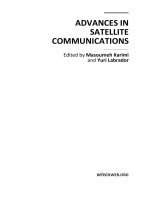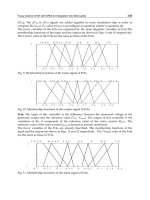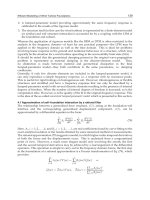Advanced Techniques in Dermatologic Surgery - part 1 pptx
Bạn đang xem bản rút gọn của tài liệu. Xem và tải ngay bản đầy đủ của tài liệu tại đây (875.78 KB, 42 trang )
Advanced Techniques in
Dermatologic Surgery
DK2146_FM.indd 1DK2146_FM.indd 1 11/14/05 12:39:09 PM11/14/05 12:39:09 PM
Process CyanProcess CyanProcess MagentaProcess MagentaProcess YellowProcess YellowProcess BlackProcess Black
BASIC AND CLINICAL DERMATOLOGY
Series Editors
ALAN R. SHALITA, M.D.
Distinguished Teaching Professor and Chairman
Department of Dermatology
SUNY Downstate Medical Center
Brooklyn, New York
DAVID A. NORRIS, M.D.
Director of Research
Professor of Dermatology
The University of Colorado
Health Sciences Center
Denver, Colorado
1. Cutaneous Investigation in Health and Disease: Noninvasive Methods and
Instrumentation, edited by Jean-Luc Lévêque
2. Irritant Contact Dermatitis, edited by Edward M. Jackson and Ronald Goldner
3. Fundamentals of Dermatology: A Study Guide, Franklin S. Glickman and Alan R.
Shalita
4. Aging Skin: Properties and Functional Changes, edited by Jean-Luc Lévêque and
Pierre G. Agache
5. Retinoids: Progress in Research and Clinical Applications, edited by Maria A.
Livrea and Lester Packer
6. Clinical Photomedicine, edited by Henry W. Lim and Nicholas A. Soter
7. Cutaneous Antifungal Agents: Selected Compounds in Clinical Prac tice and
Development, edited by John W. Rippon and Robert A. Fromtling
8. Oxidative Stress in Dermatology, edited by Jürgen Fuchs and Lester Packer
9. Connective Tissue Diseases of the Skin, edited by Charles M. Lapière and Thomas
Krieg
10. Epidermal Growth Factors and Cytokines, edited by Thomas A. Luger and Thomas
Schwarz
11. Skin Changes and Diseases in Pregnancy, edited by Marwali Harahap and Robert
C. Wallach
12. Fungal Disease: Biology, Immunology, and Diagnosis, edited by Paul H. Jacobs and
Lexie Nall
13. Immunomodulatory and Cytotoxic Agents in Dermatology, edited by Charles J.
McDonald
14. Cutaneous Infection and Therapy, edited by Raza Aly, Karl R. Beutner, and
Howard I. Maibach
DK2146_FM.indd 2DK2146_FM.indd 2 11/14/05 12:39:10 PM11/14/05 12:39:10 PM
Process CyanProcess CyanProcess MagentaProcess MagentaProcess YellowProcess YellowProcess BlackProcess Black
15. Tissue Augmentation in Clinical Practice: Procedures and Techniques, edited by
Arnold William Klein
16. Psoriasis: Third Edition, Revised and Expanded, edited by Henry H. Roenigk, Jr.,
and Howard I. Maibach
17. Surgical Techniques for Cutaneous Scar Revision, edited by Marwali Harahap
18. Drug Therapy in Dermatology, edited by Larry E. Millikan
19. Scarless Wound Healing, edited by Hari G. Garg and Michael T. Longaker
20. Cosmetic Surgery: An Interdisciplinary Approach, edited by Rhoda S. Narins
21. Topical Absorption of Dermatological Products, edited by Robert L. Bronaugh and
Howard I. Maibach
22. Glycolic Acid Peels, edited by Ronald Moy, Debra Luftman, and Lenore S. Kakita
23. Innovative Techniques in Skin Surgery, edited by Marwali Harahap
24. Safe Liposuction and Fat Transfer, edited by Rhoda S. Narins
25. Pyschocutaneous Medicine, edited by John Y. M. Koo and Chai Sue Lee
26. Skin, Hair, and Nails: Structure and Function, edited Bo Forslind and Magnus
Lindberg
27. Itch: Basic Mechanisms and Therapy, edited Gil Yosipovitch, Malcolm W. Greaves,
Alan B. Fleischer, and Francis McGlone
28. Photoaging, edited by Darrell S. Rigel, Robert A. Weiss, Henry W. Lim, and Jeffrey
S. Dover
29. Vitiligo: Problems and Solutions, edited by Torello Lotti and Jana Hercogova
30. Photodamaged Skin, edited by David J. Goldberg
31. Ambulatory Phlebectomy, Second Edition, edited by Mitchel P. Goldman, Mihael
Georgiev, and Stefano Ricci
32. Cutaneous Lymphomas, edited by Gunter Burg and Werner Kempf
33. Wound Healing, edited by Anna Falabella and Robert Kirsner
34. Phototherapy and Photochemotherapy for Skin Disease, Third Edition, Warwick L.
Morison
35. Advanced Techniques in Dermatologic Surgery, edited by Mitchel P. Goldman
and Robert A. Weiss
36. Tissue Augmentation in Clinical Practice, Second Edition, edited by Arnold W.
Klein
DK2146_FM.indd 3DK2146_FM.indd 3 11/14/05 12:39:11 PM11/14/05 12:39:11 PM
Process CyanProcess CyanProcess MagentaProcess MagentaProcess YellowProcess YellowProcess BlackProcess Black
edited by
Mitchel P. Goldman
University of California
San Diego, California, U.S.A.
and
La Jolla Spa MD
La Jolla, California, U.S.A.
Robert A. Weiss
The Johns Hopkins University School of Medicine
Baltimore, Maryland, U.S.A.
and
Maryland Laser, Skin & Vein Institute
Hunt Valley, Maryland, U.S.A.
Advanced Techniques in
Dermatologic Surgery
associate editors
Neil S. Sadick
Weill Medical College of Cornell University
New York, New York, U.S.A.
Alina A. M. Fratila
Jungbrunnen-Klinik Dr. Fratila GmbH
Bonn, Germany
DK2146_FM.indd 4DK2146_FM.indd 4 11/14/05 12:39:11 PM11/14/05 12:39:11 PM
Process CyanProcess CyanProcess MagentaProcess MagentaProcess YellowProcess YellowProcess BlackProcess Black
Published in 2006 by
Taylor & Francis Group
270 Madison Avenue
New York, NY 10016
© 2006 by Taylor & Francis Group, LLC
No claim to original U.S. Government works
Printed in the United States of America on acid-free paper
10987654321
International Standard Book Number-10: 0-8247-5405-0 (Hardcover)
International Standard Book Number-13: 978-0-8247-5405-1 (Hardcover)
Library of Congress Card Number 2005052954
This book contains information obtained from authentic and highly regarded sources. Reprinted material is quoted with
permission, and sources are indicated. A wide variety of references are listed. Reasonable efforts have been made to publish
reliable data and information, but the author and the publisher cannot assume responsibility for the validity of all materials
or for the consequences of their use.
No part of this book may be reprinted, reproduced, transmitted, or utilized in any form by any electronic, mechanical, or
other means, now known or hereafter invented, including photocopying, microfilming, and recording, or in any information
storage or retrieval system, without written permission from the publishers.
For permission to photocopy or use material electronically from this work, please access www.copyright.com
( or contact the Copyright Clearance Center, Inc. (CCC) 222 Rosewood Drive, Danvers, MA
01923, 978-750-8400. CCC is a not-for-profit organization that provides licenses and registration for a variety of users. For
organizations that have been granted a photocopy license by the CCC, a separate system of payment has been arranged.
Trademark Notice: Product or corporate names may be trademarks or registered trademarks, and are used only for
identification and explanation without intent to infringe.
Library of Congress Cataloging-in-Publication Data
Advanced techniques in dermatologic surgery / edited by Mitchel P. Goldman, Robert A. Weiss.
p. ; cm. (Basic and clinical dermatology ; 35)
Includes bibliographical references and index.
ISBN-13: 978-0-8247-5405-1 (Hardcover : alk. paper)
ISBN-10: 0-8247-5405-0 (Hardcover : alk. paper)
1. Skin Surgery. 2. Lasers in surgery. I. Goldman, Mitchel P. II. Weiss, Robert A. III. Series.
[DNLM: 1. Skin Diseases surgery. 2. Cosmetic Techniques. 3. Laser Surgery methods. 4.
Reconstructive Surgical Procedures methods. WR 650 A244 2005]
RD520.A38 2005
617.4'77 dc22 2005052954
Visit the Taylor & Francis Web site at
Taylor & Francis Group
is the Academic Division of Informa plc.
DK2146_Discl.fm Page 1 Thursday, October 13, 2005 12:05 PM
To all of our authors and all of our hardworking, dedicated colleagues who have
advanced the field of cosmetic dermatology and lasers.
And to my wife, Margaret, who puts up with my writin g and editing
way past normal bedtimes.
Robert A. Weiss
It is always a pleasure to work on a project that will help others. It is my hope
that this text will not only help our patients but all cosmetic dermatologic
surgeons in advancing and perfecting thei r techniques.
Another pleasure is to work with a close personal friend and brilliant
colleague—‘‘two heads are better than one.’’
Finally, it is wonderful to have a ‘‘Type A’’ wi fe, Dianne, who can tolerate
long hours working at home most evenin gs and many weekends across
the same desk while still having time to enjoy both our hard work
as well as the other pleasures of life together.
Mitchel P. Goldman
Series Introduction
During the past 25 years, there has been a vast explosion in new informa-
tion relating to the art and science of dermatology as well as fundamental
cutaneous biology. Furthermore, this information is no longer of interest
only to the small but growing specialty of dermat ology. Clinicians and
scientists from a wide variety of disciplines have come to recognize both
the importance of skin in fundamental biological processes and the broad
implications of understanding the pathogenesis of skin disease. As a
result, there is now a multidisciplinary and worldwide interest in the pro-
gress of dermatology.
With these factors in mind, we have undertaken this series of books
specifically oriented to dermatology. The scope of the series is purposely
broad, with books ranging from pure basic science to practical, applied
clinical dermatology. Thus, while there is something for everyone, all
volumes in the series will ultimately prove to be valuable additions to a
dermatologist’s library.
The latest addition to the series, volume 35, edited by Drs. Mitchel
P. Goldman and Robert A. Weiss, is both timely and pertinent. The
editors are well-known authorities in the fields of dermatological surgery
and cosmetic dermatology. We trust that this volume will be of broad
interest to scientists and clinicians alike.
Alan R. Shalita
Distinguished Teaching Professor and Chairman
Department of Dermatology
SUNY Downstate Medical Center
Brooklyn, New York, U.S.A.
v
Preface
The concept for this book arose from a need to provide an international
approach to the latest in cosmetic dermatologic procedures from not only
seasoned experts, but advanced thinkers. When we first approached the
publisher, the concept of a CD or DVD accompanying a textbook display-
ing the procedures discussed was completely novel. It is now not only a
reality found in many textbooks, but a necessity. We believe that combined
with written text, an accompanying video becomes an observational and
interactive learning experience which is almost as good as watching the
procedure live. The authors have produced these videos to that end.
The topics covered in this text are the core of cosmetic dermatologic
surgery: from bot ulinum toxin and fillers, to liposu ction, non-ablative
lasers, and the newest ablative lasers. What makes this text quite unique
is the inclusion of the latest sclerotherapy techniques such as foam and
endovenous procedures as well as the use of radiofrequency for skin tigh-
tening. For those of us versed in principles of dermatologic surgery, this
text takes us to the next level. Designed to be procedure oriented but com-
prehensive as a referen ce, this book is well il lustrated and designed to allow
the reader to enter the realm of expert cosmetic dermatologic surgery.
Dr. Alina A. M. Fratila was a source of great inspiration for many
of the topics covered in this text. Her relentless dedication to the
success of many meetings of the International Society of Dermatologic
Surgery of which she was President, provided the concept for a compre-
hensive international co urse on cosmetic dermatologic surgery. It is with
this in mind that this text expan ds and updates the content but keeps true
to the intent of Dr. Fratila in organizing an international team to explain
and teach modern aspects of cosmetic dermatologic surgery. We are also
indebted to Sonja and Gerhard Sattler, who organize live cosmetic
dermatologic surgery symposia in Rosenpark every other year in which
most of the procedures covered in this text can be observed live.
We truly hope that al l the readers will gain insight into procedures they
are already performing o r add additional procedures to their armentarium.
We also hope that you w ill enjoy t he international exchange of techniques
tweaked to maximize results and t he sharing of cosmetic dermatology pearls.
Robert A. Weiss
Mitchel P. Goldman
vii
Contents
Series Introduction Alan R. Shalita v
Preface . . . . vii
Contributors . . . . xv
1. Topical Anesthesia . . 1
Paul M. Friedman, Erick A. Mafong, Adrienne S. Glaich, and
Roy G. Geronemus
Introduction . . . . 1
EMLA . . . . 3
LMX
Õ
6
Betacaine-LA
Õ
8
Tetracaine
Õ
9
Topicaine . . . . 10
S-Caine Patch . . . . 10
S-Caine Local Anesthetic Peel . . . . 11
Cost Comparison . . . . 13
Conclusion . . . . 14
References . . . . 15
2. Advanced Cosmetic Use of Botulinum Toxin Type A . . 19
Alastair Carruthers and Jean Carruthers
Introduction . . . . 19
Botulinum Neurotoxins . . . . 19
Treatment of the Upper Face . . . . 22
Chemodenervation in the Mid and Lower Face and Neck . . . . 26
Adjunctive Therapy . . . . 32
Complications . . . . 34
Conclusion . . . . 36
References . . . . 37
3. Soft-Tissue Augmentation: Skin Fillers . . . . 39
Jaggi Rao, Janna Bentley, and Mitchel P. Goldman
Introduction . . . . 39
Temporary Fillers . . . . 45
ix
Permanent Fillers . . . . 55
Complications of Exogenous Soft-Tissue Augmentation . . . . 63
Conclusion . . . . 65
References . . . . 67
4. New Trends in Fat Augmentation Techniques with an Introduction
to the FAMI Technique . 71
Kimberly J. Butterwick
Introduction . . . . 71
Fat: Temporary Filler or a Living Graft? . . . . 71
Preparation Techniques . . . . 72
Harvesting Techniques . . . . 73
Injection Techniques . . . . 77
Complications of Fat Augmentation Procedures . . . . 86
Longevity of Fat Augmentation Procedures . . . . 87
Touch-Up Procedures . . . . 88
Summary . . . . 89
References . . . . 90
5. Liposuction . . . 93
Gerhard Sattler
Introduction . . . . 93
History of Liposuction . . . . 93
Tumescent Local Anesthesia . . . . 94
Physiology of Liposuction . . . . 95
Evaluation of Patients . . . . 96
Technique of Liposuction . . . . 97
Postoperative Findings . . . . 101
Noncosmetical Indications for Liposuction . . . . 102
New Developments in Liposuction . . . . 104
Summary . . . . 115
References . . . . 116
6. Laser-Assisted Blepharoplasty . . . . 117
Alina A. M. Fratila
Introduction . . . . 117
History . . . . 117
Surgical Anatomy of the Orbital Unit . . . . 118
Initial Consultation . . . . 121
Relative Contraindications . . . . 122
Preoperative Documentation . . . . 122
Laser-Assisted Upper Eyelid Blepharoplasty . . . . 123
Laser-Assisted Lower Eyelid Blepharoplasty . . . . 131
Complications and Their Treatment . . . . 145
Complications After Blepharoplasty . . . . 148
x Contents
Conclusion . . . . 156
References . . . . 157
7. Laser Hair Removal 159
Suzanne L. Kilmer
Introduction . . . . 159
Patient-Related Factors . . . . 161
Parameter Selection . . . . 164
Lasers . . . . 166
Which Is Best? 173
Patient Consent . . . . 173
Treatment . . . . 174
References . . . . 180
8. Laser Treatment of Vascular Lesions . . . . . . 185
Arielle N. B. Kauvar
Introduction . . . . 185
Lasers for Vascular Lesions . . . . 186
Clinical Applications . . . . 192
Conclusion . . . . 196
References . . . . 197
9. Laser Treatment for Leg Veins . . . 201
Neil S. Sadick
Introduction . . . . 201
Continuous Wave Nd:YAG Lasers . . . . 204
Continuous Wave Lasers . . . . 206
Pulsed Lasers and Light Sources . . . . 206
Long-Pulsed Nd:YAG Laser (1064 nm) . . . . 210
Skin Cooling Devices . . . . 211
Combined Laser/Radiofrequency Technologies . . . . 212
Conclusions . . . . 213
References . . . . 215
10. Laser Resurfacing with the UPCO
2
1 Er:YAG Lasers . 219
Mitchel P. Goldman
Introduction . . . . 219
References . . . . 238
11. The Role of Pulse Dye Laser in Photorejuvenation . . . 241
Steven Q. Wang and Brian D. Zelickson
Introduction . . . . 241
Pulse Dye Laser . . . . 242
Type II Photorejuvenation . . . . 243
Patient Treatment Protocol . . . . 247
Summary . . . . 252
References . . . . 253
Contents xi
12. Nd:YAG (1064 nm) Laser 255
David J. Goldberg
Introduction . . . . 255
References . . . . 267
13. Improvement of Acne Scars and Wrinkling with 1320 nm
Nd:YAG Laser 269
Robert A. Weiss and Margaret A. Weiss
Introduction . . . . 269
The 1320nm Device (CoolTouch
Õ
) . . . . 270
Summary . . . . 281
References . . . . 282
14. 1540 and 1450 nm Noninvasive Rejuvenation . 285
Murad Alam, Te-Shao Hsu, Jeffrey S. Dover, and Kenneth A. Arndt
Introduction . . . . 285
1540 nm Erbium:Glass Laser . . . . 286
1450 nm Diode Laser . . . . 289
References . . . . 293
15. Intense Pulsed Light and Nonablative Approaches to Photoaging . . . 295
Robert A. Weiss, Margaret A. Weiss, and Mitchel P. Goldman
Introduction . . . . 295
Wavelength . . . . 297
Spot Size . . . . 299
Pulse Durations . . . . 300
Concepts of Multiple Sequential Pulsing . . . . 302
Treatment of Photoaging with IPL . . . . 303
Treatment Technique . . . . 310
Adverse Reactions . . . . 310
References . . . . 313
16. Advanced Sclerotherapy: The Sclerosing Foam . . . . . . 317
Alessandro Frullini
Introduction . . . . 317
Foam and SF . . . . 318
Techniques for SF Preparation . . . . 321
Clinical Applications of Foam Sclerosants . . . . 323
Complications with SF . . . . 327
Conclusions . . . . 328
References . . . . 329
17. Principles and Technique of Ambulatory Phlebectomy . 331
Albert-Adrien Ramelet and Robert A. Weiss
Introduction . . . . 331
Indications . . . . 332
xii Contents
Preoperative Evaluation of the Patient . . . . 333
Instrumentation and Operating Environment . . . . 333
Patient Marking and Anesthesia . . . . 335
Technique . . . . 337
Postoperative Medication and Prophylactic
Anticoagulation . . . . 339
Postoperative Care and Bandaging . . . . 339
Results . . . . 340
AP of Body Areas Other Than the Legs . . . . 341
Complications and Their Treatment . . . . 341
Long-Term Results . . . . 344
References . . . . 345
18. Endovenous Elimination of the Great Saphenous Vein with
Radiofrequency or Laser . . . . . . . 347
Robert A. Weiss and Mitchel P. Goldman
Introduction . . . . 347
RF Endoluminal Obliteration (Closure
TM
) . . . . 348
RF Closure
TM
Using Duplex Guided Cannulation . . . . 350
RF Closure
TM
with Ambulatory Phlebectomy . . . . 352
Tumescent Anesthesia for Endovenous Procedures . . . . 354
Clinical Technique for RF Closure
TM
355
Follow-Up Care . . . . 357
Endovenous Obliteration of the GSV with Endoluminal Laser Ablation
(810 nm, 940 nm, and 980 nm) . . . . 357
CoolTouch CTEV
TM
Endovenous Treatment . . . . 359
Technique of CoolTouch CTEV
TM
Endovenous Treatment . . . . 362
Summary . . . . 363
References . . . . 364
19. Radiofrequency Tissue Tightening: Thermage 367
Carolyn I. Jacob and Michael S. Kaminer
Introduction . . . . 367
Mechanism of Action . . . . 368
Clinical Scientific Data . . . . 372
Treatment Protocols . . . . 376
Discussion . . . . 388
References . . . . 390
Index . . . . 391
Contents xiii
Contributors
Murad Alam Section of Cutaneous and Aesthetic Surgery, Department of
Dermatology, Northwestern University, Chicago, Illinois, U.S.A.
Kenneth A. Arndt SkinCare Physicians, Ches tnut Hill, Massachusetts, U.S.A.;
Department of Dermatology, Harvard Medical School, Boston, Massachusetts,
U.S.A.; Department of Medicine (Dermatology), Dartmouth Medical School,
Hanover, New Hampshire, U.S.A.; and Section of Dermatologic Surgery and
Cutaneous Oncology, Department of Dermatology, Yale University School of
Medicine, New Haven, Connecticut, U.S.A.
Janna Bentley University of Alberta, Edmo nton, Alberta, Canada
Kimberly J. Butterwick Dermatology/Cosmetic Laser Associates of La Jolla,
La Jolla, California, U.S.A.
Alastair Carruthers Division of Dermatol ogy, University of British Columbia,
Vancouver, British Columbia, Canada
Jean Carruthers Department of Ophthalmology, University of British Columbia,
Vancouver, British Columbia, Canada
Jeffrey S. Dover Department of Medicine (Dermatology), Dartmouth Medical
School, Hanover, New Hampshire, U.S.A.; Section of Dermatologic Surgery and
Cutaneous Oncology, Department of Dermatology, Yale University School of
Medicine, New Haven, Connecticut, U.S.A.; and SkinCare Physicians, Chestnut
Hill, Massachusetts, U.S.A.
Alina A. M. Fratila Jungbrunnen-Klinik Dr. Fratila GmbH, Bonn, Germany
Paul M. Friedman Department of Dermatology, University of Texas Medical
School, DermSurgery Laser Center, Houston, Texas, U.S.A.
Alessandro Frullini Studio Flebologico, Incisa Valdarno, Florence, Italy
Roy G. Geronemus Ronald O. Perelman Dep artment of Dermatology,
New York University School of Medicine, Laser and Skin Surgery Center of New York,
New York, New York , U.S.A.
xv
Adrienne S. Glaich Department of Dermatol ogy, DermSurgery Laser Center,
University of Texas, Houston, Texas, U.S.A.
David J. Goldberg Skin Laser & Surgery Specialists of New York & New Jersey,
and Mount Sinai School of Medicine, New York, New York, U.S.A.
Mitchel P. Goldman Department of Dermatology/Medicine, University of
California, San Diego, California, U.S.A. and La Jolla Spa MD, La Jolla,
California, U.S.A.
Te-Shao Hsu SkinCare Physicians, Chestnut Hill, Massachusetts, U.S.A.
Carolyn I. Jacob Northwestern Medical Scho ol, Department of Dermatology,
Chicago Cosmetic Surgery and Dermatology, Chicago, Illinois, U.S.A.
Michael S. Kaminer Department of Dermatology, Yale Medical School, Yale
University, New Haven, Connecticut, U.S.A.; Department of Medicine
(Dermatology), Dartmouth Medical School, Dartmouth College, Hanover,
New Hampshire, U.S.A.; and SkinCare Physicians of Chestnut Hill, Chestnut Hill,
Massachusetts, U.S.A.
Arielle N. B. Kauvar New York University School of Medicine, New York,
New York, U.S.A.
Suzanne L. Kilmer Laser and Skin Surgery Center of Northern California,
Sacramento, California, U.S.A.
Erick A. Mafong University of California, San Diego, California, U.S.A.
Albert-Adrien Ramelet Spe
´
cialiste FMH en Dermatologie et en Angiologie,
Lausanne, Switzerland
Jaggi Rao University of Alberta, Edmonton, Alberta, Canada
Neil S. Sadick Weill Medical College of Cornell University, New York,
New York, U.S.A.
Gerhard Sattler Center for Cosmetic Dermatologic Surgery, Rosenparkklinik,
Darmstadt, Germany
Steven Q. Wang Department of Dermatology, University of Minnesota School of
Medicine, Minneapolis, Minnesota, U.S.A.
Margaret A. Weiss Department of Dermatology, The Johns Hopkins University
School of Medicine, Baltimore, Maryland, U.S.A.
Robert A. Weiss Department of Dermatolog y, The Johns Hopkins University
School of Medicine, Baltimore, Maryland, U.S.A.
Brian D. Zelickson Department of Dermatology, University of Minnesota School
of Medicine and Skin Specialists Inc., Abbott Northwestern Hospital Laser Center,
University of Minnesota, Minneapolis, Minnesota, U.S.A.
xvi Contributors
1
Topical Anesthesia
Paul M. Friedman
Department of Dermatology, University of Texas Medical School, DermSurgery
Laser Center, Houston, Texas, U.S.A.
Erick A. Mafong
University of California, San Diego, California, U.S.A.
Adrienne S. Glaich
Department of Dermatology, DermSurgery Laser Center, University of Texas,
Houston, Texas, U.S.A.
Roy G. Geronemus
Ronald O. Perelman Department of Dermatology, New York University School of
Medicine, Laser and Skin Surgery Center of New York, New York,
New York, U.S.A.
INTRODUCTION
With the emergence of new laser and surgical techniques, the need
for more e ffective topical ane sthesia continues to gr ow. There are now
several topical prepar ations of local anesthetics that are being used prior
to various dermatologic procedures. Eutectic mixture of local anesthetics
(EMLA) is the most frequently used agent prior to dermatologic proce-
dure s; however, there has bee n a recent release of newer topical anes-
thetics claiming increased efficacy and faster onset of action. We review
and compare the efficacy of several commonly used topical anesthetics
and provide a glimpse into the future developments in this field.
Topical anesthetics are weak bases typically composed of three
important components: an aromatic ring, an intermediate length ester
or amide linkage, and a tertiary amine. The ester anesthetics have an ester
linkage, while the amide anesthetics have an amide linkage between the
aromatic ring and the intermediate chain (Fig. 1). Ester-type topical anes-
thetics are metabolized by plasma cholinesterase and other nonspecific
esterases, while the amide anesthetics are primarily metabolized in the
liver via the microsomal enzymes. Allergic contact reactions to the
ester group of anesthetics are common, while reactions to amide anes-
thetics, including lidocaine and prilocaine, are rare (1,2). The metabolite
p-aminobenzoic acid (PABA) formed by ester hydrolysis is capable of
1
causing allergic reactions in a small pe rcentage of patients (3). Ester-
linked anesthetics are contraindicated in patients with allergies to PABA,
hair dyes, and sulfonamides .
Topical anesthetics prevent the initiation and transmission of nerve
impulses and provide cutaneous analgesia by targeting free nerve endings
in the dermis. Topical anesthetics block nerve impulse conduction by
interfering with the function of sodium channels. By inhibiting sodium
flux, the threshold for nerve excitation increases until the ability to gene-
rate an action potential is lost.
The stratum corneum is the main barrier in topical anesthetic deli-
very to the free nerve endings in the dermis (4). The aromatic portion is
primarily responsible for the lipid solubility that allows diffusion across
the nerve cell membrane, governing the intrinsic potency of these agents
(5,6). Both the aromatic and the amine portion determine protein-binding
characteristics, which are thought to be the primary agents of anesthesia
duration (6).
Different methods for evaluating and comparing anesthetic efficacy
have included venipuncture (7–13), pinprick testing (14), split-thickness
skin graft donation (15–17), and laser pulses as pain stimuli. Laser-
induced thermal pain stimuli are advantageous for comparing topical
anesthetics by providing reproducible, quantifiable stimuli with minimal
intraindividual variation (18–20). Laser pulses also provide selective
activation of nociceptors, without interference from mechanosensitive
receptors (19).
Figure 1
Chemical structure of ester and amide anesthetics.
2 Friedman et al.
EMLA
EMLA cream is a 5% eutectic mixture of two local anesthetics, lidocaine
and prilocaine (Astra USA, Westborough, Massachusetts). It was
released in the United States in 1993 and is composed of 25 mg/mL of lido-
caine and 25mg/mL of prilocaine in an oil-in-water emulsion cream. A
eutectic mixture is defined as a compound that melts at a lower temperature
than any of its components (21). Using a eutectic system, Fredrick Broberg
discovered that equal parts of lidocaine and prilocaine produced adequate
analgesia after topical application to the skin (22). The formulation allowed
for a concentration of 80% of the anesthetics in oil droplets. However, a
low overall concentration of 5% was maintained in the vehicle, thus
minimizing systemic toxicity associated with higher concentrations (23).
EMLA is the most widely used topical agent with proven efficacy
from several clinical trials (7–19). Multiple studies have shown its useful-
ness in producing dermal analgesia in patie nts treated for molluscum con-
tagiosum and venereal lesions, venepuncture in children, shave biopsies,
dermabrasion in tattoo removal, and debridement of venous leg ulcers
(7–13). Additionally, EMLA has provided sufficient analgesia for har-
vesting split-thickness skin grafts afte r a 90-minute application period
(15). Lahteenmaki et al. (16) in a dose-finding study demonstrated that
15 gm of EMLA applied to each 100 cm
2
area with application times of
two to five hours provided enough analgesia to perform split-thickness
skin graft harvesting. More recently, Gupta and Sibbald (24) demon-
strated that either EMLA cream or patch app lied for two to three hours
provided sufficient analgesia in 87% of the subjects for the performance
of minor skin surgical procedures such as excisional biopsy or curettage
and electrosurgery.
EMLA can also provide cutaneous analgesia for various laser pro-
cedures. Many studies have shown that EMLA is effective in reducing or
eliminating pain associated with pulsed-dye laser treatments (25,26).
Ashinoff and Geronemus (27) demonstrated that EMLA was a safe
and effective topical anesthetic which could be used in the treatment of
port-wine stains with the pulsed-dye laser. The use of EMLA did not
interfere with the clinical efficacy of the pulse-dye laser, despite the fact
that local vasoconstriction occurred in cutaneous blood vessels. EMLA
has also been shown to provide effective anesthesia to laser-induced pain
stimuli produced by the Q-switched Nd:YAG laser after a 60-minute
application period (Figs. 2–4) (20).
EMLA produces dermal analgesia after application under an occlu-
sive dressing for 60 minutes, with inadequate analgesia after applica-
tion for only 30 minutes (28–30). Increased dermal analgesia is seen with
up to two hours of occlusion (31). Dermal analgesia has been shown
to continue and even increase for 15 to 60 minutes after its removal
(18,20,28). This is likely due to a reservoir of an esthetic that accumulates
in the stratum corneum during the occlusion period (18,28). After the anes-
thetic is removed, the diffusion continues from the stratum corneum to the
sensory nerves located in the dermis. Arendt-Nielsen and Bjerring (18),
Topical Anesthesia 3
based on their study, recommend application of EMLA cream under
occlusion one hour prior to laser treatment followed by its removal
prior to the procedure, thereby increasing its ability to reduce pain during
treatment.
The required application period of EMLA may vary depending on
the site of treatment. EMLA has been shown to be effective on the
face and thighs after as little as 25 minutes (32). On mucosal surfaces,
Figure 2
Mean pain scores after application of topical anesthetics for 60 minutes.
p-values represent comparisons of each anesthetic with the control. LMX
Õ
was statistically superior to Tetracaine
Õ
and Betacaine-LA
Õ
at 60 minutes,
while EMLA was statistically superior to Betacaine-LA
Õ
at 60 minutes. Abbre-
viations: EMLA, Eutectic mixture of local anesthetics. Source: From Ref. 20.
Figure 3
Mean pain scores 30 minutes after removal of the topical anesthetics. All anes-
thetics were superior to control. Source: From Ref. 20.
4 Friedman et al.









